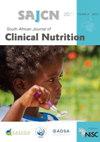Field-testing of the revised, draft South African Paediatric Food-Based Dietary Guidelines among mothers/caregivers of children between the ages of 3 and 5 years in the Northern Metropole, City of Cape Town, Western Cape province, South Africa
IF 0.6
Q4 NUTRITION & DIETETICS
引用次数: 3
Abstract
Objective: To assess the appropriateness and understanding of the revised, draft South African Paediatric Food-Based Dietary (SA-PFBDGs) among mothers/caregivers of children between the ages of 3 and 5 years. Exposure to similar messages, barriers and enablers were also assessed. Design: A qualitative, descriptive, cross-sectional study design was followed. Participants were purposively recruited to participate in 9 focus-group discussions (FGDs) conducted in isiXhosa, English and Afrikaans totalling 55 participants. Setting: Formal and informal urban communities along the West Coast, in the Northern Metropole, City of Cape Town, Western Cape, South Africa. Subjects: Mothers/caregivers older than 18 years who provided informed consent. Results: The majority of the participants mentioned previous exposure to messages similar to the revised, draft SA-PFBDGs mainly from healthcare workers, health facilities and the media. Cultural differences and taste preferences contributed to poor following of healthy eating guidelines, specifically regarding lean meats and chicken, dry beans, split peas, lentils and soya, salt, fat and sugar. With regard to dietary variety and fresh fruit and vegetables, availability and financial barriers existed. Understanding nutritional needs of children, supportive communities and education were strong enabling factors for following of the revised, draft SA-PFBDGs. Conclusion: Overall, the guidelines were familiar and understood. However, the comprehension of some guidelines must be clarified further, specifically those pertaining to sugar, salt and fat. The design of appropriate educational materials for the revised draft SA-PFBDGs, complementing national actions, could help to minimise inconsistent messages on young-child nutrition and create a supportive environment for improved nutritional health.在南非西开普省开普敦市北部大都市对3至5岁儿童的母亲/照顾者进行南非儿童食品膳食指南修订草案的现场测试
目的:评估3至5岁儿童的母亲/照顾者对修订后的南非儿童食品膳食(sa - pfbdg)草案的适当性和理解程度。还评估了接触类似信息、障碍和促成因素的情况。设计:采用定性、描述性、横断面研究设计。参与者被有意招募参加9个焦点小组讨论(fgd),共55名参与者用西班牙语、英语和南非荷兰语进行。背景:在南非西开普省开普敦市北部大都会,沿着西海岸的正式和非正式城市社区。受试者:年满18岁且提供知情同意的母亲/照顾者。结果:大多数参与者提到以前接触过与修订后的sa - pfbdg草案类似的信息,主要来自卫生保健工作者、卫生机构和媒体。文化差异和口味偏好导致人们很少遵守健康饮食指南,特别是在瘦肉和鸡肉、干豆、豌豆、扁豆和大豆、盐、脂肪和糖方面。在饮食种类和新鲜水果和蔬菜方面,存在可获得性和财政障碍。了解儿童的营养需求、支持性社区和教育是遵循修订后的sa - pfbdg草案的有力促成因素。结论:总体而言,指南是熟悉和理解的。然而,对某些指南的理解必须进一步澄清,特别是那些与糖、盐和脂肪有关的指南。为修订的《准则-方案-目标》草案设计适当的教材,补充国家行动,有助于尽量减少关于幼儿营养的不一致信息,并为改善营养健康创造有利的环境。
本文章由计算机程序翻译,如有差异,请以英文原文为准。
求助全文
约1分钟内获得全文
求助全文
来源期刊

South African Journal of Clinical Nutrition
NUTRITION & DIETETICS-
CiteScore
2.50
自引率
9.10%
发文量
21
期刊介绍:
1.The Journal accepts articles from all basic and applied areas of dietetics and human nutrition, including clinical nutrition, community nutrition, food science, food policy, food service management, nutrition policy and public health nutrition. 2.The Journal has a broad interpretation of the field of nutrition and recognizes that there are many factors that determine nutritional status and that need to be the subject of scientific investigation and reported in the Journal. 3.The Journal seeks to serve a broad readership and to provide information that will be useful to the scientific community, the academic community, government and non-government stakeholders in the nutrition field, policy makers and industry.
 求助内容:
求助内容: 应助结果提醒方式:
应助结果提醒方式:


